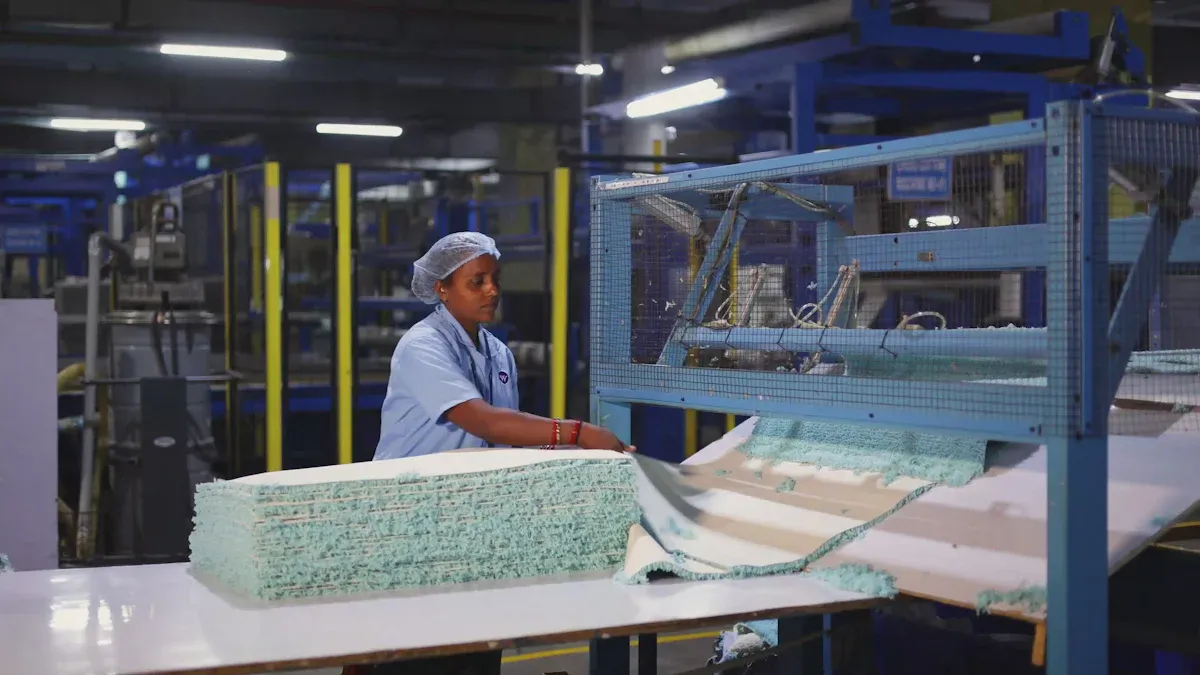What is Overall Equipment Effectiveness and How to Calculate It

Overall equipment effectiveness is a key way to check efficiency. It shows how well machines work by looking at uptime, speed, and product quality. For example, an OEE of 85.89% means the machine works well 86% of the time. If OEE goes down, problems like delays or bad products happen. Fixing these problems can help make more products, waste less, and use machines better. This leads to better results in making things.
Understanding Overall Equipment Effectiveness
What Does OEE Measure?
OEE checks how well machines work during production. It looks at three main things: availability, performance, and quality. Availability shows how often machines run without stopping. Performance checks if machines work at the best speed. Quality makes sure products meet standards without mistakes. These three together show how efficient your equipment is.
For example, availability can drop if repairs or material delays happen. Performance slows down with small stops or speed changes. Quality problems come from errors or too many defects. OEE helps find where these problems are so you can fix them.
A study found that many machines work below the ideal 85% efficiency. This means there’s a lot of room to improve in factories. By reducing downtime and keeping machines running smoothly, you can raise your OEE score.
Why Is OEE Important in Manufacturing?
OEE is important for making factories work better. It gives a clear way to measure how efficient machines are in different places and times. By finding problems, OEE helps improve how things are made.
Factories use OEE to make better use of workers, materials, and machines. High OEE scores mean more products and lower costs, which helps businesses compete. Watching quality also reduces waste and fixes.
Reports show OEE improves production and service. It matches lean manufacturing ideas by focusing on useful work time. While 85% OEE is great, many factories can still do better. Using OEE data can turn problems into chances to grow.
Components of OEE

Availability: Checking Machine Running Time
Availability shows how long machines work compared to planned time. It helps reduce downtime from breakdowns, setup changes, or missing materials. To find availability, divide the actual working time by the scheduled time. For example, if a machine was planned to run for 8 hours but worked for 6 hours, availability is 75%.
Tip: High availability means machines are ready when needed. This lowers delays and boosts efficiency.
Factor | Formula |
|---|---|
Availability | Run Time / Planned Production Time |
Tracking availability helps spot problems like frequent breakdowns or long setups. Fixing these issues can improve your OEE score.
Performance: Checking Machine Speed
Performance checks if machines run at their best speed. It compares actual production speed to the fastest possible speed. If machines run slower than their ideal time, performance drops. Small stops, idling, or slower speeds often cause this.
For example, if a machine makes 90 units per hour but could make 100, performance is 90%. This helps find slowdowns and improve production speed.
Performance affects how much you produce and earn.
Slow speeds or stops lower your OEE score.
Measuring performance shows where to make improvements.
Factor | Formula |
|---|---|
Performance | (Ideal Cycle Time x Total Pieces) / Run Time |
Quality: Checking Defect-Free Products
Quality measures how many products meet standards without mistakes. It ensures the output is good and ready to use. To calculate quality, divide the number of good products by the total made. For example, if you make 1,000 units and 950 are good, quality is 95%.
Note: High quality means fewer mistakes, less waste, and better resource use.
Factor | Formula |
|---|---|
Quality | Good Pieces / Total Pieces |
Improving quality raises your OEE score and cuts costs from fixing or wasting products. Industries like medical devices often have high OEE scores because they focus on quality.
OEE Calculation Explained

The OEE Formula: Availability × Performance × Quality
The OEE formula is simple to understand. It multiplies three main factors: availability, performance, and quality. Each factor shows a different part of how well your equipment works:
Availability checks how much time the machine runs as planned.
Performance looks at whether the machine runs at top speed.
Quality measures how many products are made without defects.
When you multiply these three, you get the OEE score. This score shows how effectively your equipment is being used.
For example, if availability is 85%, performance is 82%, and quality is 96%, the OEE would be:
OEE = 0.85 × 0.82 × 0.96 = 0.67 (or 67%)
This formula helps find areas to improve, like reducing downtime, speeding up production, or making better products.
Step-by-Step Guide to OEE Calculation
Follow these steps to calculate OEE:
Find Availability
Subtract downtime (like repairs) from planned production time.
Use this formula:
Availability = (Actual Operating Time / Planned Production Time) × 100%Example: If the machine was planned to run 10 hours but worked 8.5 hours:
Availability = (8.5 / 10) × 100% = 85%
Find Performance
Compare actual speed to the fastest possible speed.
Use this formula:
Performance = (Ideal Cycle Time × Total Units Produced) / Actual Operating Time × 100%Example: If the machine makes 90 units per hour but could make 100:
Performance = (90 / 100) × 100% = 90%
Find Quality
Check how many products are defect-free.
Use this formula:
Quality = (Good Units / Total Units Produced) × 100%Example: If 140 units are made and 135 are good:
Quality = (135 / 140) × 100% = 96%
Combine the Results
Multiply availability, performance, and quality to get the OEE score.
Example:
OEE = 0.85 × 0.90 × 0.96 = 0.73 (or 73%)
Example of OEE Calculation with Real Data
Here’s a real-world example of calculating OEE:
Availability Calculation
Planned time: 10 hours (600 minutes).
Downtime: 1.5 hours (90 minutes).
Actual time: 600 - 90 = 510 minutes.
Availability:
Availability = (510 / 600) × 100% = 85%
Performance Calculation
Ideal cycle time: 0.5 minutes per unit.
Total units: 900.
Performance:
Performance = (0.5 × 900) / 510 × 100% = 88.2%
Quality Calculation
Total units: 900.
Defective units: 30.
Good units: 900 - 30 = 870.
Quality:
Quality = (870 / 900) × 100% = 96.7%
Overall OEE Calculation
OEE:
OEE = 0.85 × 0.882 × 0.967 = 0.725 (or 72.5%)
This example shows how real data can help calculate OEE and find ways to improve.
Here’s a summary in table form:
Metric | Calculation | Result |
|---|---|---|
Availability Rate | 510 / 600 | 85% |
Performance Efficiency | (0.5 × 900) / 510 | 88.2% |
Quality Rate | 870 / 900 | 96.7% |
Overall Equipment Effectiveness | 0.85 × 0.882 × 0.967 | 72.5% |
To make it clearer, here’s a chart comparing performance percentages with time metrics:
By using these steps, you can calculate OEE and improve your production process.
Practical Applications of OEE
Improving Production Scheduling
OEE helps improve production schedules by finding inefficiencies. By studying availability, performance, and quality, you can spot delays. Adjusting schedules based on this data makes machines work better. For example, using advanced planning systems like MRP can boost OEE by 22%. This shows how matching schedules to machine abilities improves results.
Better scheduling reduces idle time and uses machines fully. A study found MRP systems can raise production efficiency by 24%. These systems help manage resources well, keeping production smooth and meeting goals.
Cutting Downtime and Waste
OEE helps lower downtime and waste in factories. By tracking machine performance, you can find common problems. Fixing these with preventive maintenance or quick changeovers helps a lot. A study on Total Productive Maintenance (TPM) showed big improvements:
KPI | Before TPM | After TPM |
|---|---|---|
OEE | 60% | 85% |
Downtime | 15% | 4% |
Maintenance Costs | $200,000/year | $120,000/year |
Less downtime means more productivity and lower costs. For instance, one company cut downtime from 50 hours to 10 hours monthly using TPM. These changes save money and improve efficiency.
Using OEE for Ongoing Improvement
OEE helps you improve your factory over time. One car parts maker used OEE to fix downtime and quality issues. They collected data and did preventive maintenance, raising their OEE score and cutting waste.
An electronics company improved OEE by 15% by standardizing assembly lines. This reduced errors, improved training, and boosted productivity. A pharmaceutical company raised OEE by 14% with lean manufacturing workshops. These workshops taught workers how to keep high standards.
Using OEE creates a habit of improving, keeping your factory competitive and efficient.
FAQ
What is a good OEE score for manufacturing?
An OEE score of 85% or more is great. It means machines are running well in time, speed, and quality. If the score is lower, it shows problems. Fixing these issues can help make more products and waste less.
How can you improve OEE in your factory?
To improve OEE, cut downtime and run machines faster. Make sure products are high quality. Do regular maintenance, plan better, and train workers. Watching OEE data shows where to make changes.
Why is OEE important for small businesses?
OEE helps small businesses use machines better. It finds problems, lowers costs, and boosts production. By focusing on time, speed, and quality, small businesses can compete with big companies and meet customer needs.
Can OEE be applied to all industries?
Yes, OEE works in any industry using machines. It checks how well machines work in factories, hospitals, food plants, and more. Tracking OEE helps improve work, cut waste, and keep quality steady.
What tools can help you track OEE?
You can use software like MES or OEE apps. These tools collect data and show how machines are doing. They make tracking easy and help you decide how to improve.
See Also
Essential Tips for Choosing MES and WMS in 2025
How Cutting Die Blanking Enhances Manufacturing Productivity
Understanding QFD, FMEA, And DOE's Impact on Quality
Exploring CAE Analysis Advantages for Die Casting Design
Ten Strategies to Enhance Route Cards in Manufacturing
About Hunan Puka
Established in 2016 and based in Hunan, China, with a liaison point in Berlin, we are a Tier 2 supplier for the automobile industry. We specialize in the production of customized aluminum die-casting parts designed for machines with a closing force ranging from 280 to 1250 tons, with subsequent manufacturing process CNC machining and surface treatment. Our commitment to quality is reflected in our accredited quality management system, certified by ISO9001:2015 and IATF16949:2016 standards.


